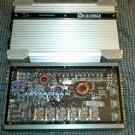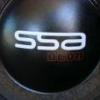Leaderboard
Popular Content
Showing content with the highest reputation on 03/04/2010 in all areas
-
2 pointsI don't know if I'd go so far as to call them a stupid idea. They operate on the principle that our perception of low frequencies is based as much on tactile sensation (the feeling of vibration/etc in your body) as it is through actually hearing the sound. This is especially true of sound at the very bottom of the audible spectrum and those below the audible spectrum. Below ~20hz you don't even hear the sound, it's all tactile sensation down there. While not a whole lot of music goes this low unless you drive around listening to classical orchestra music, special effects in movies can have a lot of action down there. Reproducing low frequencies at realistic levels in a home or theater can be challenging, especially on a budget and without dedicating a lot of space to a subwoofer system. With a tactile transducer like the Bass Shaker, you can obtain the sensation of low frequency reproduction without requiring a significant and powerful subwoofer system. So while they aren't really necessary for car audio, they can serve a useful purpose in other genres of audio reproduction. How "realistic" they feel would probably be an individual opinion.....but I suppose at the very worst, having an unrealistic representation isn't as bad as none at all.
-
1 pointIf you are going to go with 1 subwoofer get an 18" so you can get more cone area. If you really want to try DC out then you should get an 18" DC LVL 5 its a monster, and its rated 2k wrms so your hifonics amp should be fine. You should get a sub that you are going to stick with.. one that will impress you for a long time, then.. when you get more paper get another one! You shouldnt spend a stack on a temp system like.. 2 12's then plan on upgrading later to a totally different set up. If it were me, id get one monster that you can upgrade by adding another one, along with another amp. this is all my opinion though, take what you want from it buddddy
-
1 pointVery few people here will tell you to go for Kicker. There are dozens of subs in the market! If you just want to be loud, it's easy with 2000 watts rms. Do you really want to get rid of your backseats ? A ported box for 2 15"s is huge. For one 15 it can be around 5 cu ft gross. 1 sub is enough on 2000 watts, but you can have 2 if you got the room available. Look at Fi : bl (if you want 2 subs), btl(one sub)Incriminator Audio DP, DR,...DC audio LVL 4, 5 ?SSA Xcon ( not the loudest, but the most "ACCURATE") I run one, and I love it a lot more than my ex Kicker L7 S15Ascendant Audioand many moreTake your time to read all you can about these subs on this forum ! Good luck
-
1 pointI don't. Could care less about it. I want my shit to sound great, that is the most important thing to me. Doesn't mean I didn't go through the I want to be loud stage, but I grew out of that one.
-
1 pointLots of other choices for some 15's bro. Check out all the subs available on this site and others like DC and Fi. Some people may give you suggestions based on what they have only heard by word of mouth rather than experience. I would do as much research as possible before you drop the loot. Give us plenty of info about the available airspace (maximum height, depth, width). You want to make sure that whatever drivers you purchase have space for the optimal enclosure.
-
1 pointWhy? CO2 doesn't degrade anything that I know of. Dissolving carbon dioxide gas into water produces slight levels of carbonic acid as a byproduct
-
1 pointyou can buy one for $20-$25. No need to go crazy, but in this hobby you will need one. It's priceless.
-
1 point
-
1 pointCheck the coils with a DMM if you haven't already. Maybe it's right just labeled wrong.
-
1 pointJust like JAY-CEE said if your not satisfied with your setup then do the upgrade. and just because the amp is more powerful doesn't mean you HAVE to add another sub. Actually I would suggest getting a bigger amp anyways to give you some head room and just dial down the gains to what the subs can handle. my .02
-
1 point
-
1 pointYou would not want to do that primarily because that would completely change the characteristics of the crossover. At minimum the crossover frequencies would change, but if there were other elements to the passive crossover design they would also be rendered useless and not function as intended. In short....there would be a drastic, undesirable change to the performance of the crossover and thus the sound. Depends completely on the flexibility and features of the crossover and how many amplifier channels you have available. And since you gave us absolutely no information about the amplifier, crossover flexibility or features, number of amplifier channels available, etc......we aren't able to answer this question.
-
1 pointHave you tried the JL site? It can be pretty helpful. JL Audio Finding the port area is as simple as L x W. So if your port opening is 4"W x 20"H, you will have 80in2 of port area. For 12-16 rule, a 5ft3 enclosure would be fine up the the 16 mark. 5 x 16= 80in2
-
1 pointFor $120 you should really just buy a bigger single driver and build a ported enclosure. Don't fry that amp using it in house without a good DC power supply...
-
1 point
-
1 pointGains are really a bit independent here. Dynamic capability is what is important. Pretend you put a sine wave in (which I know doesn't have a crest factor, but it may be confusing for readers to talk about gain setting with dynamic music) the overall output of the amp would be 10w. It wouldn't matter if you had your headunit nearly maxed and the gain down or your headunit off and the gains up. The point was you were outputting 10w and that the amplifier has the capability of more. *obviously this requires you keep things within the input/output range of the amp, but other than that the gain is independent* Now change the analogy from a sine wave to music, leave the settings the same but have an output power of 10w with music and apply that to what Impious said above.
-
1 pointCrest Factor Before we can discuss amplifier headroom, we first need to discuss the music we are listening to. And the concept we need to understand is that of crest factor. Sine waves are the simplest tone. Sine waves are the "test tones" that many people use in this hobby for various reasons, although most likely familiar to everyone as the source used in the typical SPL competition. Sine waves are a periodic waveform. That is, these sine waves or test tones are quite simply a repeating waveform with equal intervals and amplitude in time. Music, in contrast, is very dynamic and transient. Music is a nonperiodic wave form. Meaning music is composed of sounds that frequently vary amplitude, vary in tone and last for varying periods of time. Most sounds and peaks in music last for very brief periods of time, many times only for a fraction of a second. Both sine waves and music have an "average level" and a "peak level". The peak level is the highest output level achieved by the tone or music. What we are concerned about is the difference between that average level and the peak level. And that difference is known as crest factor. Sine waves have a crest factor of 3db. Meaning the peak of the signal is 3db higher than the average level of the signal. Music on the other hand has a crest factor of 10db - 20db (or more) depending on the dynamics of the music and the amount of compression. On newer music, the compression is (unfortunately) typically higher reducing the dynamics and thus reducing the crest factor to the lower end of that spectrum. Higher quality recordings with less compression will be on the upper end of the crest factor spectrum with a crest factor of around 20db or more. The System Now that we understand a little bit about the music we're listening to, let's discuss how it relates to your system. So what does a crest factor of 10db or 20db mean? Well, we can use the formula 10*log(X/Y) to determine how much of a power increase is required to increase output by 10db and 20db. 10*log(10/1) = 10db 10*log(100/1) = 20db This means the amplifier must increase power by a factor of 10 to increase output by 10db and a factor of 100 to increase output by 20db. In other words, that dynamic peak of 10db will require your amplifier provide 10x the power over the average level. And to meet a 20db dynamic peak, it would require the amplifier output 100x the power over the average level. Sounds like a lot, eh? It is! So if you are using an amplifier with an unclipped power output capability of 100w, and you are listening to music with a crest factor of 20db then the average output you would be able to obtain from the amplifier and avoid clipping the dynamic peaks is 1w. The same amplifier with a crest factor of 10db, the average output would be 10w. What happens if we want to listen to our 20db crest factor music at a higher average level than just 1w of output on our 100w amplifier? Well, you certainly can.....but you will end up clipping the dynamic peaks. Going back to what we said before about the nature of music, it's very transient. Those large peaks will occur over very short durations of time and change rapidly. Due to various reasons our brain can handle some amount of clipping without negative audible effects. But it is also possible, depending on the amount of clipping, original crest factor of the music and frequency regions involved, etc, that this clipping could result in harsh or compressed sounding dynamics at higher output listening levels. This is because of the increase in distortion as a result of clipping, and due to the forced reduction of the level of the dynamic peak compared to the average level of the music. An undesirable result indeed. There are, of course, other issues involved with clipping such as potential damage to components such as speakers, but that's best left to another thread as it can be quite involved in-and-of itself. Headroom This leads us to the utility of amplifier headroom. And also the reason I'm a huge advocate of purchasing the most power your budget will allow. What is meant by the term "headroom"? It means having excess power reserves or capabilities available from the amplifier for use during those dynamic peaks to avoid clipping the amplifier and the resultant negative effects it can have on the sound of the system. The two ways of obtaining this headroom are as follows; The first is "headroom" inherent to the amplifier itself, the second is headroom allowed by purchasing an amplifier with higher power capabilities. For headroom inherent to the amplifier itself, we need to consider the way amplifiers are measured. Amplifiers power rating can be done in several ways. The first, and most commonly cited, is continuous average power (incorrectly called "RMS" power). This should be the output capabilities of the amplifier measured over extended periods of time at some distortion figure, generally 1% or less, at some supply voltage, generally 12V-14.4V. It is, however, possible to measure an amplifiers output on very short periods of time, typically fractions of a second. This is referred to as music power or dynamic power. For most typical amplifier designs, this will not change significantly enough from the continuous power output capabilities to really matter in the grand scheme of things. It is, however, possible to design an amplifier that has considerably higher dynamic power than it does continuous power output capabilities. One more extreme example of this is Rockford's 15kw amplifier with it's enormous bank of internal capacitors that can't sustain long term output support but can greatly increase power output for short term "bursts". Other companies have designed more practical applications of increasing dynamic power, but these are the exception and not the rule. Do not confuse the real measure of dynamic or music power with the fictional marketing term used by many low end companies, which in their lingo is essentially an ILS rating. That leaves use with the second consideration to increasing headroom; Buying an amplifier with higher power capabilities than we may think we need. Looking back at how power increases with regard to dynamic peaks, it's easy to see how this could be beneficial. Compare, for example, a 50w amplifier and a 200w amplifier. Let's just say, to keep things simple, that we are listening to music with a crest factor of 10db and we are listening at an average level that requires 10w of output from the amplifier. When those 10db dynamic peaks occur, they will require a 10x increase in power, to 100w. If we are using a 50w amplifier, then these peaks would require the 50w amplifier to output twice it's unclipped output capabilities.....which means we will be clipping the amplifier during those peaks, potentially leading to the ill effects previously listed. In this particular scenario, you reduced your unclipped dynamic headroom capabilities from the necessary 10db to 7db. On the other hand, if we are using the 200w amplifier and that 10db dynamic peak occurs, we are still well under the amplifier's capabilities....removing the worry about clipping and the resultant increase in distortion and compressed dynamics. Does everyone need a 200+ watt-per-channel amplifier? Certainly not. But it does explain why it makes sense to look for the amplifier with the highest power capabilities out of the viable options within your budget. All else equal (build quality, features, aesthetic value, etc) it's generally advisable to go with the higher powered amplifier. Where it can be avoided, there's no reason to make available power the limiting factor to the performance of your system. Allow yourself the necessary headroom when choosing amplification for your system. If that's a 50wpc amplifier or a 300wpc amplifier is a decision for you to make. Now, you may be thinking; But wait! My speakers are only rated at 50w, what in the heck will happen when they receive that 100w dynamic peak?! Well, the short answer here is that a speaker's power rating is typically a thermal rating based on it's ability to sustain that power level over an extended period of time. Again, due to the transient nature of music, those dynamic peaks are occurring over very short periods of time. Due to the short time frame of that dynamic peak, the speaker will quickly dissipate the heat. Speakers can handle much more power over very short periods of time than they can over longer periods of time.
-
1 pointNo load = infinity ohms = Open circuit Full load = as little as 0 ohms = Short circuit I think you have this backwards... Short protection DOESN'T do anything for a no load connected condition. It is designed to shut the amplifier off when there is a short circuit across the output presenting a load close to 0 ohms to the amplifier. Most amplifiers DO NOT have circuit protection for no load or infinite ohms, this is because solid state amplifiers should have no trouble driving this load (or lack of load), unless they are defective. Some (poor) designs may oscillate if there is no load load connected because of output dampening, but I am 99.9% sure that is not your case, or any case with even the cheapest car audio amps. If you had your amplifier hooked up right it should have never smoke from no load connected, even if you were clipping the amp. Something was wrong with the amp or the install, double check again....
-
1 pointThe only way you would damage the scope is to put to much voltage on the input, I think most scopes can handle the output voltage of an amp. An amp shouldn't immediately fail if it is driving an open or high impedance load... Here is what could have happened... Where you using a DC power supply to test the amp, or in car? If you were using a grounded DC supply and hooked the scope to the output of the amp, you may have inadvertantly grounded out the amp output (the clip or shield of the scope probe is tied to chassis ground) and most amps don't like that at all... In car it isn't a big deal because the vehicle ground will be isolated from the scope ground.
-
0 pointsMy birthday is in July and I'm trying to decide what to do with the money I get (yes, I'm 30 years old and still get money ). I do know that I want to upgrade sub/subs, but I'm not quite sure which way to go. Budget will be between $200-$250. Not sure if I could swing $300, but it's a possibility. I've got 600 @ 2 ohms to work with. The main thing is I'd like to keep the box size down as much as possible. I don't want to go over 2 cubes total, and even that's pushing it. So, I'm thinking either 2 8's or 10's in a small sealed box, or a single 10" or 12" ported. I'd love to try a 15" since I've never run one before, but I don't want to choke it down into too small of a box. I'm not looking to compete, and I'm not out to impress anyone except myself. I just want a good sounding, decently loud daily driver. I'm mainly looking at Sundown, IA and SSA.
-
0 pointsyeah fuck that shit, if you ordered it correctly and they messed up then it should be fixed. Its an easy mistake though... they put the wrong thing in the wrong box, we're all human. EDIT: they put the wrong thing in the RIGHT box.
-
-1 pointspshh, SSDs are weak. The old version with BP and copper coils could only handle 1500 watts daily. See what I did there. hehe.
-
-1 points
-
-1 pointsWhat if someone threw 500 of these in their trunk on 2,000w rms? (The Beast(s)) Totally stupid, but i had to get a second opinion.
-
-2 pointsI dont have any dc shit, havent even heard it......but dude, kicker....come on now....that is the most whored out name on ebay....you want shit cheap then go with it...but if you want quality in both the build or sound of a woofer...i'd bet dc is better, look at fi, ssa, sundown....lots of good shit out there for the money....













